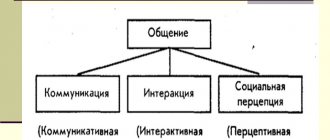Have you ever been told that you are great to talk to? Communication requires the presence of at least two people. It's an interaction anyway. And wherever you are: at home, at work, on the street, on public transport - everywhere you are surrounded by people with whom you will come into mutual contact. And communication will be effective when both you and your interlocutor receive back everything that you spent in the communication process.
For example, you spend your energy, time, strength, emotions, resources, and in return you also receive even more energy, positive emotions, even some kind of material result, help, etc. And in the same way, your interlocutor receives results from communicating with you, that is, in the end, the communication was effective for both of you.
In this article:
What is the difference between effective and ineffective communication Technologies of effective communication - what are they What is important for effective communication Ineffective communication techniques A very important rule in communication “Three Twenty” 8 powerful techniques for effective communication
What is the difference between effective and ineffective communication?
Photo by MART PRODUCTION: Pexels
If you invest your resource when communicating with someone, and get nothing in return, then this communication devastates you, it is ineffective. You probably sometimes noticed that after talking with some person, it was as if the energy had been drained from you, and after that you weren’t like that at all. Have you ever had this?
So, if you want to interact effectively with people, get the most out of communication, attract people to you, understand and feel every person, you can learn this. You will simply become a fairy sorceress who will captivate everyone who enters into dialogue with you with her attention. So, let's begin.
Express your attitude
Sometimes being effective in an important conversation is hindered by a person’s inability to conduct it correctly. Communicating is not only exchanging words and general phrases, but also expressing your attitude to the subject or topic of conversation. If a person does this, then he gives the impression of awareness and understanding of the topic of conversation.
Expressing an attitude means being able to correctly and competently tell your opponent what you personally think about this matter, instead of using vague characteristics of other people’s opinions. It also means talking about your own experiences. The expression of the attitude must be supported by conclusions that are understandable and logical.
Read also: How to make a bootable USB flash drive with macOS
Effective communication technologies – what are they?
Effective communication technologies are methods, techniques and means of communication that fully ensure mutual understanding and mutual empathy between communication partners. In a word, these are simple but effective tools for mutual understanding in communication.
Empathy (sympathy) is a conscious experience of the emotional state of other people, the ability to recognize what they feel and express compassion.
There are a lot of ways, techniques and means. Millions of books have been written on the topic of communication, because communication is an entire art, and once you master it, you will become an expert in interaction.
Basic communication techniques
There are also methods of communication, or methods of speech influence. These are specific recommendations for increasing the effectiveness of communication. For example, the rule “Approaching the interlocutor increases the effectiveness of speech influence on him” is implemented in communication practice in the form of the following techniques: “Come closer!”, “Invade the personal space of the interlocutor!”, “Touch the interlocutor!”
The following techniques help to establish relationships of mutual understanding:
1. eye contact, as well as smiling and other means of non-verbal communication. Smile sincerely and avoid using gestures that establish barriers (do not sit cross-legged, do not cross your arms, do not turn away from the interlocutor);
2. handshake. Physical contact is an important moment in establishing a relationship. Your handshake should convey to the other person your actual desire to “get closer” and “touch” them;
3. verbal greeting. Your greeting should be appropriate to the situation in which you are meeting to fulfill your intentions. You can address your partner by name if it suits the situation. In Russia, it is customary to call a partner by name and patronymic;
4. the first words of greeting, which must comply with the rules of business etiquette, but preferably in the form of open questions (for example: “what?”, “when?”, “how?”);
5. your attitude. Be genuinely interested in the interaction. Your attitude will ensure good communication if you show genuine interest and respect for your partner;
6. your behavior. Ask open-ended questions. Listen carefully. Use your partner's answers in part to ask the following questions. Give your partner important or necessary information about yourself. Ask your partner to express his opinion on the issue being discussed. Use situationally appropriate humor;
7. clear communication. Use short but clear statements on the essence of the subject of communication; end your sentences with questions, use ties for positive answers
8. adequacy and pace. In a well-balanced partner relationship, there is a regular rotation of responsibility for setting the pace. Try to match your partner in speed of speech, intonation, breathing rhythm, gestures, postures
9. Establishing trust. The most effective way to build trust is by being honest; be honest about your fears, weaknesses, motives. If there is this kind of information, then it is better to share it with your partner than for him to learn about it from other sources
A person needs to be communicatively literate and know the above laws and rules. Effective communication and a culture of communication must be learned as the basics of literacy, as the ability to read and write. Because this is truly literacy that everyone needs: we all make many gross mistakes every day that make our life, already difficult, even more difficult. We all the time make comments to strangers, give advice to those who do not ask us, criticize people in front of witnesses, and do many other things that absolutely cannot be done according to the laws of communication in a civilized society. All this prevents us from achieving results at work, it prevents us from living normally in our families, communicating with children, close and not so close people, and leads to increased conflict in communication.
It has been established that our business contacts will be successful in 7 cases out of 10 if we also know the rules of business communication.
QUESTIONS FOR SELF-CONTROL
1. What are the laws of communication?
2. What are their features?
3. List the basic laws of communication.
4. What are the rules of communication? How do they differ from the laws of communication?
5. What rules of communication do you know?
6. What are communication techniques?
7. What techniques help to establish relationships of mutual understanding?
What is important for effective communication
To learn how to communicate effectively with people, you need to take into account the fact that almost everything matters:
- Exactly what you are saying.
- The way you talk.
- The way you can listen to your interlocutor.
- What emotions you experience.
- What emotions the interlocutor experiences.
- Whether you understand what emotions the interlocutor is experiencing.
- The way you use sign language.
Effective Communication Techniques
Criticism is not the end of the world
Many people in the first stages of mastering the skill of effective communication are afraid of criticism from others. This doesn't make any sense. Competent, objective criticism can help you see mistakes and weaknesses that you yourself would never have noticed. Hateful criticism, said only to hurt you, is not worth your attention. Do not react to such statements under any circumstances, and do not rush to prove something to such an interlocutor. Your peace of mind will look much more dignified. When choosing how to respond to the words or actions of others, pay attention to those that suggest calm and a positive message.
Concept and types of communication
If we consider the way of life of various higher animals and humans, we will find that it has two sides: contact with nature and contact with living beings. The first type of contact is called activity, the second type is characterized by the fact that the interacting parties are living beings that exchange information from organism to organism. This type of intraspecific and interspecific contact is called communication.
Communication is characteristic of all higher organisms, but at the human level it takes the most advanced forms, being conscious and mediated by language.
Communication is a complex, multifaceted process of establishing and developing contacts between people, which arises from the need for joint activities; it includes the exchange of information, the development of a general strategy for interaction, perception and understanding of the partner.
Communication is the interaction of two or more subjects, carried out through signs caused by the needs of joint activity and aimed at a significant change in the state, behavior and personal and semantic formations of the partner. It consists of a mutual exchange of messages with factual and emotional aspects.
In its most general form, communication functions as a form of life activity. Its social significance lies in the fact that it functions as a means of transmitting forms of culture and social experience.
The specificity of communication is determined by the fact that in the process of its implementation the subjective world of one person is revealed to another. In communication, a person defines himself and represents himself, revealing his individual characteristics. By the form of influences one can judge a person’s communicative abilities and character traits, and by the peculiarities of the organization of a speech message - about general culture and literacy.
The following aspects are distinguished in communication: Content, purpose and means. Content is information that is transferred from one living being to another during interpersonal contacts. The content of communication can be information about the internal motivational or emotional state of a living being. A person may convey information about current needs to another person with the expectation that he will be able to participate in satisfying those needs.
The content of communication can be information about the state of the external environment, transmitted from one living being to another, for example, danger signals or the presence of positive, biologically significant factors, for example, food, somewhere nearby.
In humans, the content of communication is much broader than in animals. People exchange information with each other, representing knowledge about the world, rich, acquired life experience, knowledge, skills, abilities. Human communication is multidisciplinary in nature; it is most diverse in its internal content.
The purpose of communication is the reason why a person carries out this type of activity. In animals, the purpose of communication may be to motivate another creature to perform certain actions, or to warn that it is necessary to refrain from a certain action. For example, a mother warns her child of danger with her voice or movement; some animals in a herd can alert others when they perceive signs of life.
No less significant are the differences in the means of communication. They can be defined as methods of encoding, transmitting, processing and decoding information transmitted from one living being to another in the process of communication.
Encoding information is a way of transmitting it from one living being to another. For example, information can be transmitted through direct physical contact: touching the body, hands, etc. Through the senses (observing the movements of one person by another or perceiving sound signals produced by another person), information can be transmitted and perceived by people at a distance.
Psychology of dealing with arrogant people
In life we meet different people, and we must be ready for any communication. Often on our path in life we encounter insolent people - these are people who behave shamelessly and arrogantly in order to achieve their own goals and benefits. They don't take anyone's opinion into account, don't care about other people's feelings, and believe that they are always right.
You can behave differently with arrogant people. For example, respond to rudeness with rudeness, ignore, manipulate, put in place. It all depends on the situation and who is in front of you. Being rude to your boss will be fraught with danger, for example.
- The first thing you need to do is not be afraid to say no. You need to be tough and not fall for any persuasion or manipulation. If you don't understand the refusal, start ignoring it.
- Try not to stoop to the level of insolence, no matter how much you want to be rude. This way you will be involved in his dirty game and are unlikely to be able to verbally defeat a born boor.
- The main goal of an insolent person is to throw you off balance and force you to do what he wants. So try to remain patient and calm. Drive him crazy with your calmness and let him go looking for another victim.
- Never allow anyone to violate your personal boundaries and mind their own business. You have every right to protect your personal space.
You must understand that all methods of effective communication are based on understanding yourself and your interlocutor. You must learn to understand people, understand who you are dealing with. In any case, respect, acceptance and awareness of the value of each person are the basis of successful communication.









